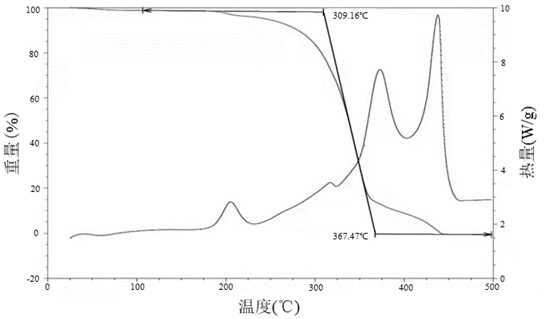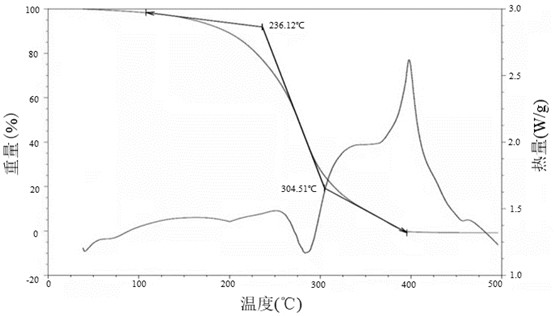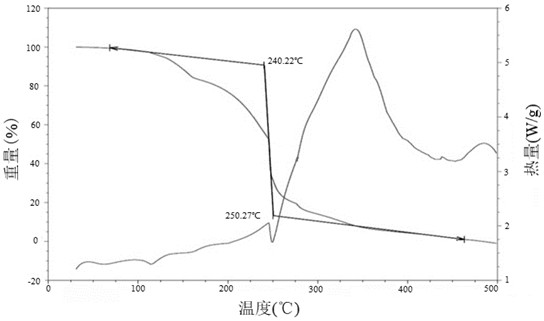Front silver paste for solar cell with low contact resistance and high photoelectric conversion efficiency and preparation method of front silver paste
A technology of photoelectric conversion efficiency and low contact resistance, which is applied in the preparation of organic compounds, the preparation of oxygen-containing functional groups, and conductive materials dispersed in non-conductive inorganic materials, etc. The problem of low tension level and high decomposition residual ash can achieve high photoelectric conversion efficiency, avoid incomplete purification and small smooth conduction.
- Summary
- Abstract
- Description
- Claims
- Application Information
AI Technical Summary
Problems solved by technology
Method used
Image
Examples
specific Embodiment approach 1
[0038] Embodiment 1: In this embodiment, a front silver paste for solar cells with low contact resistance and high photoelectric conversion efficiency is composed of 85 to 95 parts by weight of silver powder, 1.8 to 3.0 parts of glass powder, and 7 to 12 parts by weight. prepared from an organic carrier;
[0039] The organic carrier is formed by 72 to 86 parts of solvent, 4 to 10 parts of binder, 2 to 5 parts of thixotropic agent, 0.5 to 1.5 parts of dispersant, and 2 to 4 parts of plastic in parts by weight. agent, 5-9 parts coupling agent, 3-4 parts defoaming agent and 0.2-0.6 part auxiliary agent;
[0040] Described binder is polyethyl 5-hydroxy-2-pentenoate;
[0041] Described thixotropic agent is pentaerythritol tetrakis (9-amino-10-hydroxy octadecanoic acid) ester;
[0042] The dispersant is poly-5-(N,N-dimethylamino)-1,4-pentanediol monotriethylamine ether.
specific Embodiment approach 2
[0043] Embodiment 2: The difference between this embodiment and Embodiment 1 is that the silver powder is high tap density spherical small particle size silver powder, and the tap density is 6.0g / cm 3 ~6.5g / cm 3 , the particle size D of high tap density spherical small particle size silver powder 50 0.4μm~1.5μm, D 100 ≤2.8μm. Other steps are the same as in the first embodiment.
specific Embodiment approach 3
[0044] Embodiment 3: The difference between this embodiment and Embodiment 1 or 2 is that the glass powder is a high tensile lead-free glass powder, and the glass powder is 30 to 45 parts by weight of TeO 2 , 15 to 32 Bi 2 O 3 , 12 to 20 B 2 O 3 , 1 to 5 parts of SiO 2 , 0~1 part CaO, 1 part~2 part MgO, 1.5 part~3 part ZnO, 1 part~1.5 part Li 2 O, 0.4 to 1 part Al 2 O 3 , 5~10 parts ZrO 2 , 3~5 parts MoO 3 , 2 to 4 parts of PtO 2 , 1.5 to 3 parts of SrO, 0.5 to 2 parts of WO 3 , 1 to 3 copies of V 2 O 5 , 0~1 part Nb 2 O 5 and 0~1 ReO 2 composition. Other steps are the same as in the first or second embodiment.
PUM
| Property | Measurement | Unit |
|---|---|---|
| Tap density | aaaaa | aaaaa |
| Particle size | aaaaa | aaaaa |
| Particle size | aaaaa | aaaaa |
Abstract
Description
Claims
Application Information
 Login to View More
Login to View More - R&D
- Intellectual Property
- Life Sciences
- Materials
- Tech Scout
- Unparalleled Data Quality
- Higher Quality Content
- 60% Fewer Hallucinations
Browse by: Latest US Patents, China's latest patents, Technical Efficacy Thesaurus, Application Domain, Technology Topic, Popular Technical Reports.
© 2025 PatSnap. All rights reserved.Legal|Privacy policy|Modern Slavery Act Transparency Statement|Sitemap|About US| Contact US: help@patsnap.com



